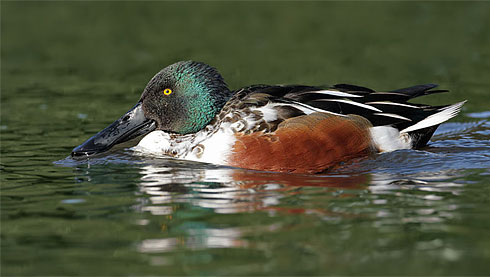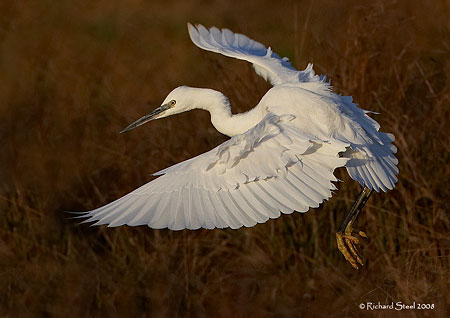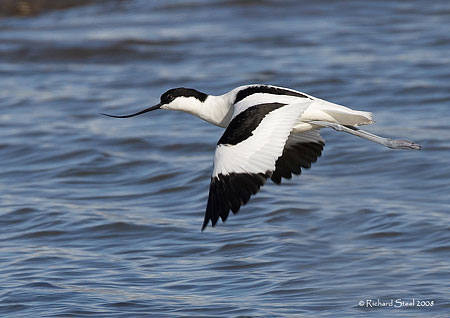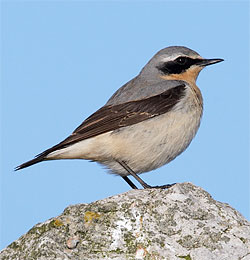Site menu:

April 2008 Newsletter
Wetland Bird Surveys.
Neston Reedbed Voluntary Wardens.
March Bird News.
Forthcoming Events.
Latest Newsletter.
Waterbirds in the UK 2005/06 - The Wetland Bird Survey
Dee Estuary WeBS Annual Report 2006/07
These two
publications are now available:
Waterbirds in the UK 2005/06 can either be downloaded for free from
the BTO website or purchased as a hard
copy - see the BTO Website.
To purchase copies of the Dee Estuary WeBS Report please contact the RSPB
at Burton Point Farm on 0151 336 7681, or call in at Inner Marsh Farm.

during February 2008, © Steve Round.
These two reports are full of fascinating facts and figures, trends and graphs, all of which give us an insight into how our wetland birds are doing both nationally and on the Dee Estuary.
If you browse through the UK report you certainly get the impression that the majority of species are doing well across the country, with numbers either increasing or stable - which is good news. Inevitably there are some which aren't doing quite as well and two species which appear to be in a long term decline nationally are Mallard and Dunlin. For Mallard this decline has been reflected on the Dee Estuary where numbers have decreased from c5,000 in the mid-1980s to just above 1,000 today. The UK report suggests a number of possible reasons for this decline but emphasises the need for more research. Numbers of Dunlin on the Dee Estuary have actually increased fairly steadily since 1980 somewhat bucking the national trend, although there have been lower numbers over the past three years. Interestingly over the past nine years the decline in this country has been mirrored by an increase in the Netherlands, strongly suggesting that the birds are short-stopping on the Wadden Sea, probably due to the mild winters.
The Dee Estuary remains the second most important site for Shelduck in the country. The most important being the nearby Mersey Estuary where, in 2005/06, numbers peaked at 15,605 in July due to the large flock of moulting birds. We also get moulting birds on the Dee Estuary and these seem to be increasing in number with 3,000 present in the summer of 2006.
The Dee Estuary is the most important site in the country for Pintail, numbers appear to have stabilised just above 6,000 here after falling to as low as 2,356 a few years ago.

The story told by the reports about Little Egrets is an intriguing one. Numbers appear to have stabilised along the south coast whereas along the north edge of their range - in particular the Dee Estuary, the Wash and Lavan Sands (North Wales) - numbers are increasing at a phenomenal rate. The increase between the years 01/02 and 05/06 for these three sites respectively is: 18 to 109, 6 to 139 and 6 to 107. Indeed, the Dee Estuary's current max count of 204 (summer 2007) would give it the third highest count in the country going on 05/06 figures! I find it particularly intriguing that despite the rapid increase in numbers at these sites there appears to be very little sign of any sizeable movement further north - for example the max count in Lancashire in 2006 was only 18. You would have thought that the Ribble Estuary would be as suitable for this species as the Dee obviously is.
Despite relatively low Oystercatcher numbers on the Dee Estuary for several years we are still the third most important site in the country for this species. There are indications that numbers increased this last winter (07/08) although I haven't seen any official figures. A new Cockling Regulation Order due to be in place later this year should make it easier to keep strict control of the cockling fishery. Cockles are, of course, the main prey item for Oystercatchers.
In 2005/06 the Dee Estuary was the most important site in the country for Black-tailed Godwits, a species which has increased rapidly over the past ten years both here and in the country as a whole. For the first time in WeBS history the max count of Black-tailed Godwits in the UK was higher than that for Bar-tailed Godwits.
The Dee Estuary continues to be the second most important wintering site in the country for Redshank, and the most important site for passage birds - there were 12,367 counted in September 2005.
In 2005 there was a large influx of non-breeding Little Terns at Gronant late on in the breeding season giving a total of 411, easily the highest count in the country that summer.
The above is just a very brief summary of these WeBS reports, for those with an interest in the conservation and well-being of all the wetland birds of the Dee Estuary I can highly recommend these publications.
References:
1. Musgrove, A.J., et al., 2007, Waterbirds in the UK
2005/06: WeBS, BTO/WWT/RSPB/JNCC, Thetford.
2. Friswell, N. (compiler) and Wells, C.E. (editor), Dee Estuary WeBS Annual Report
2006/07.
3. White, S.J., et al., Lancashire Bird Report 2006.
Any WeBS (Wetland Bird Survey) data in this article should not be used in any way without permission of the WeBS Office. To access official WeBS data please contact the WeBS Office - BTO, The Nunnery, Thetford, Norfolk IP 24 2 PU http://www.bto.org.
Voluntary Wardens Needed to Protect Neston Reed Bed

Once again the RSPB are organising voluntary wardening at Neston Reed Bed, the scheme will begin March 20th and run through until the end of May. Wardening will take place each evening in order to protect this important habitat from disturbance. I know in the past this scheme has attracted birders who have realised what a good opportunity this location is for some serious birdwatching with the possibility of seeing migrating Ospreys and Marsh Harriers, large numbers of Little Egrets flying in to roost, Bearded Tits, Hen Harriers, Short-eared Owls and the numerous birds which breed in the reed bed. If you are interested please contact Stuart Taylor (Stuart.Taylor@rspb.org.uk) or Geoff Robinson (Geoffrey.Robinson@rspb.org.uk), telephone 0151 336 7681.
March Bird News

Apart from the very early arrival of the first White Wagtail the migration was very similar to 2007 with the early migrants earlier than the average for the past few years then the following birds held up by persistent north winds.
| Species | 2008 | Location (08) | 2007 | 2006 |
|---|---|---|---|---|
| White Wagtail | 9th March | Leasowe | 13th March | 19th March |
| Wheatear | 13th March | Denhall Quay | 12th March | 23rd March |
| Swallow | 15th March | Hilbre | 16th March | 25th March |
| Sand Martin | 16th March | Inner Marsh Farm | 15th March | 26th March |
| Willow Warbler | 31st March | West Kirby | 3rd April | 31st March |
| House Martin | 1st April | 29th March | ||
| Whitethroat | 15th April | 17th April | ||
| Cuckoo | 15th April | 29th April | ||
| Swift | 16th April | 16th April |
An intense low pressure system overhead on the 10th when a 10m tide was predicted resulted in a tide which swept in over the marshes giving excellent views of Short-eared Owls and Water Rails at Parkgate. Unexpectedly there wasn't much wind, that came two days later, but may be just as well as otherwise we might have had severe flooding. Although the tide didn't completely cover the marsh on the previous two days, it did come in far enough to disturb six Short-eared Owls, excellent views of these were had by the few of us who ventured north from Parkgate towards Gayton Lane.

on March 10th when the marsh was completely covered, © Ken Roberts.
Single Hen and Marsh Harriers were observed several times through the month on the marshes, although somewhat elusive.
Gales blew in Kittiwakes and Little Gulls into North Wirral. The max count of Little Gulls was 71 off Hilbre, these were thought to be wind blown birds from the Irish Sea over-wintering population rather than birds migrating north.
A Cetti's Warbler (one of a pair?) proved something of a challenge to birders at Neston Old Quay but it did show itself occasionally with also the odd burst of song to make the wait worthwhile. Snow Buntings were still present early in the month with three on West Kirby Shore on the 8th. Mid-month saw a good movement of Stonechats with 10 at Leasowe Lighthouse and 12 on Neston Marsh both on the 14th.
Two drake Scaup took to hanging around Heswall Gutter for several days, bringing back memories of the wintering flock which used to be present 20 years ago. 133 Brent Geese counted early in the month on Hilbre had dwindled down to 103 by the 29th, still a very high number for March.
What to expect in April

Wheatears will be one of many spring migrants pouring through our area in April, and as you can see from the table above these will include our first House Martins, Whitethroats, Cuckoos and Swifts.
The last two Aprils have been fabulous for rarities - last year we had White-tailed Eagle, Red-breasted Flycatcher and Black Kite and the year before the highlights were a Sub-Alpine Warbler, Alpine Swift and Long-eared Owl.
Apart from the rarities above one species in particular April 2007 will be remembered for more than any other is the Ring Ouzel with a total of at least 21 including two long stayers when we can normally expect just a handful passing through quickly.
Out in the estuary bird numbers will have dropped right off but still well worth a visit. Shelducks will all be paired off with many nesting locally and you may will get lucky and see a 10,000 strong flock of Knots passing through to their breeding grounds in the far north after wintering far to the south of us.
Out to sea we should have our first Sandwich, Common and Little Terns back. Little Gulls will be migrating through Liverpool Bay on their way to Seaforth and Crosby Marine Lake, where they pause before moving overland to the North Sea and onwards to the Baltic Sea to breed.
Forthcoming Events
April Highest Spring Tides (Liverpool)
Also see
Tides page.
6th April, 12.14hrs (BST), 9.9m.
7th April, 12.55hrs (BST), 10.0m.
8th April, 13.36hrs (BST), 10.0m.
Forthcoming Events
Organised by the
Wirral Ranger Service ,
Flintshire Countryside Service and/or the RSPB:
All these events and walks have bird interest, even those not advertised
specifically for birdwatching. No need to book for these events unless
specified - please check below. The Wirral Parks and Countryside
Newsletter which contains events and activities from October 2007 to March
2008 can now be downloaded -
click here
(this is a 3mb PDF file).
Monday
7th April, 11.30am, Parkgate
Birdwatch.
High tide at Parkgate is the best time to discover the hidden treasures of
RSPB Dee Estuary reserve. If the tide reaches the wall, small mammals such
as voles, shrews and possibly water rails are flushed out. Meet at the Old
Baths car park overlooking the Dee Estuary Reserve at Parkgate, close to
The Boathouse pub (HW 12.55 10.1m).
For details contact the RSPB on 0151 336 7681. No need to book.
Tuesday
8th April, 12.00, Parkgate
Birdwatch.
Another chance to learn about the birdlife of this important saltmarsh
reserve. If the tide is high enough flocks of waders will be joined by
raptors such as peregrines, hen harriers and short-eared owls. (HW 13.36,
10.0m). For details contact the RSPB on 0151 336 7681.
Saturday 12th April, 2pm Start,
A Walk around Moreton.
Join members of the Wirral Footpaths
and Open Spaces Preservation Society for a walk around Moreton looking at the
Ditton Park Nature Area, Leasowe Common and Moreton Shore. This event is
suitable for all the family to enjoy. Sorry no dogs. Suitable clothing and
footwear are essential. No need to book. Meet at the Birket Bridge, Pasture
Road, north of Moreton railway station. For further enquiries ring
0151 677 6250.
Sunday 13th April, 6am – 9am, Spring
Forward.
Enjoy an early morning nature ramble along the hedgerows and across the
farmland and foreshore of West Wirral on this Ranger-led guided walk. Try
to spot Brown Hares, spring migrants and early wildflowers or just come
along to enjoy the fresh spring air. Please bring warm waterproof clothing
and binoculars if you have them. Sorry no dogs.
Booking essential, ring 0151 648 4371/3884 or
book on-line.
Sunday
20th April, 09.30 am,
High Tide at Point of Ayr.
The spit and saltmarsh at the Point of Ayr are extremely important
habitats for birds. They come alive at high tide with waders coming in to
roost and there a good some spring migrants. Join the RSPB Warden to watch
the action as it unfolds (HW 12.13, 9.2 m) No need to book. Meet at the
end of Station Rd. Talacre. Please wear warm waterproof clothing and stout footwear.
For further information contact the RSPB on
0151 336 7681.
Thursday 24th April, 10.30am – 4pm, Working
Wildlife Photography.
Local wildlife photographer Ron Thomas (ARPS) is running this practical
one-day course on photographing the natural world. Based in the lecture
theatre at Wirral Country Park and including field sessions in various
habitats, this down to earth course will appeal to beginners and keen
amateurs alike. There is a £10 charge per person for this event. Sorry no
dogs.
Booking essential, ring 0151 648 4371/3884 or
book on-line.
Saturday
26th April, 07.00 am,
Morning Walk to Burton Point.
Join the RSPB wardens on a walk through, farmland, and saltmarsh looking
for migrant birds as well as taking in the views from Burton Point. A good
chance to see birds like Wheatear and maybe something a little more
exciting like last years White Tailed Eagle !!
Please wear warm waterproof clothing and stout footwear.
Cost £6 members and £7 non members, Includes Breakfast.
Contact 0151 3367681 for further details and booking. Booking Essential!
Sunday 4th May, 4.30am – 6.30am, Dawn Chorus on the Dales.
Experience this magical time of day with the Rangers and members of Wirral
Wildlife and listen to the birdsong on the heathland as the sun rises over
the Heswall Dales Local Nature Reserve
and the Cleaver Heath Local Nature Reserve. This event is suitable for all
then family to enjoy. Sorry no dogs.
Booking essential, ring 0151 648 4371/3884 or
book on-line.
Sunday 4th May, 6am – 8am, Catching the Warbler Wave.
The hedgerows and meadows at Wirral Country
Park are buzzing with warblers busy with nests and young during the
summer. Join the Rangers for a guided walk to search for and learn more
about these amazing sub-Saharan migrants. Please bring binoculars if you
have them. Sorry no dogs.
Booking essential, ring 0151 648 4371/3884 or
book on-line.
|
 |
The blank (UK) Birding Webring is a collection of quality birding web sites that are based in the United Kingdom. Visit the webring homepage for more information, or A complete list of all the sites in the webring is available by clicking here. previous site in ring : random site in ring : next site in ring |